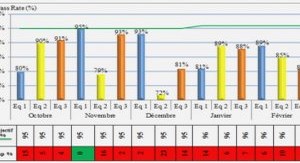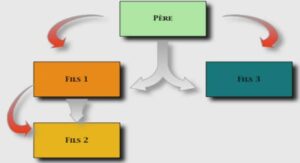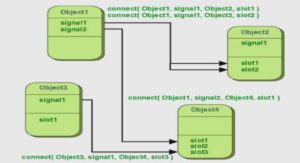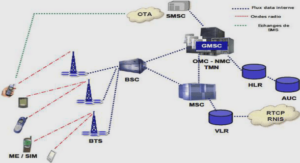Minéralisations cuprifères supergènes dans le district Centinela, désert d’Atacama, Chili
Fission track analyses
Principles
The low-temperature thermochronology fission track method, proposed by Price and Walker (63), is based on the spontaneous fission of natural uranium present in U-enriched minerals as zircon, apatite or titanite (Fleischer et al., 65). Natural uranium presents 3 natural isotopes, 238U, 235U and 234U with respective abundances of 99.3%, 0.72% and <0.01%. Due to the extremely low 234U abundances, only 238U and 235U are considered in this system. They both decay through alpha ejection, emitting a 4He atom (see (U-Th)/He method part) but only 238U present the specificity to experience both α-ejection and spontaneous nuclear fission measurable at the geological time scale (Donelick et al., 05). During spontaneous fission the initial nucleus splits in two fragments emitting two high energy neutrons. Those two daughter elements ionized leave a latent trace after the emission. Steps of their formation are resumed in Figure 3.6. Unusually in geochronological systems, the daughter element measured is an optical mineral defect. Figure 3.6 ‒ Fission track formation due to ion spike explosion model. FromTagami and O’Sullivan (05) after Fleischer et al. (75). 74 This defect called fission track is the proxy to the daughter element from 238U that is measured in this method. To complete the pair of parents and daughter element, the parent’s element concentration need to be assessed. To this aim is used the 235U isotope that is sensible to reaction causing fission useful to recover the concentration of 238U knowing the 238U/235U ratio (7.88, Steiger and Jäger, 77). Bombing the grains with a neutron flow in a nuclear reactor with an external detector as a muscovite sheet that registers induced fissions in its structure, provokes the apparition of induced fission tracks in the structure of this muscovite sheet. The ionization flow of the nuclear reactor is quantified using dosimeters (CN5 in this study). This method provides two elements of information: 1. an age of the closure of the mineral system (by density counting of both spontaneous fission tracks on the grain and induced fission tracks in the external detector) and 2. a cooling speed pattern (by fission track length measurement).
Fission track annealing
Fission tracks are only retained in the grain when the temperature of the sample is below the closure temperature. This temperature varies depending on which mineral it is performed. In the case of apatite, the T°C is about 1 ± °C. If the sample stayed a significant time below the T°C and above 60°C, fission tracks length can be reduced, this is called the partial annealing process (Naeser, 79). Fission tracks are not naturally visible. They need to be etched with acids (nitric or fluoric regarding if it is applied to apatite or muscovite) to be revealed. When a track intercepts the surface, it forms a “hole” called etch pit and its measure is called the Dpar. The counting and measuring will only be performed on grains that are upon the c-axis in the mount, which is the largest axis of the grain and the only permitting the measure of Dpar. In the other axes of the grain the intersection of the fission track with the surface would result in non-measurable and distinguishable shapes. The counted tracks are those intersecting the polished grain surface. The fission tracks measured to apprehend the annealing processes are the one parallel to the surface (Figure 3.7) that intersect cleavage (TINCLE, tracks in cleavage) or other tracks (TINTS, tracks in tracks). Figure 3.7 ‒ A. Cartoon of confined fission tracks and illustration (Tagama and Sullivan, 05) where the surface is parallel to the c-axis of the grain, with different interceptions between countable tracks and confined tracks, and illustrative picture of a track in cleavage (TINC). The measure of a hundred confined-track length (Green, 85; Laslett et al., 82) and their distribution permits to acquire more information about the complexity of sample thermal history (Figure 3.8). This technique can be performed on intrusive and on detrital samples. In the second case, we can recover the thermal history of basins can be recovered or also process to sedimentary sourcing by detrital ages distribution analysis. . One of the major factor influencing the annealing process, is the chemical composition of the apatite (Green et al., 86; Carlson et al., 99; Barbarand et al., 03; Ketcham et al., 07). Chlorine and Rare Earth Elements are elements influencing the closure temperature of the system. 76 An alternative to the chemical composition measurement using microprobe is the measure of the etch pit size named Dpar which is a proxy of the mineral composition (Barbarand et al., 03).
Counting specificities
After irradiation both spontaneous in the grain mount (𝜌s) and induced in the muscovite sheet (𝜌i) fission tracks density are measured by counting each track into a specific surface on grains from the same sample in the case of crystalline rocks and 0 grains for detrital rocks. The fission track age can be calculated with the following formula: 𝑡 = 𝟏 𝛌𝛂 𝐥𝐧 ( 𝝆𝒔 𝝆𝒊 . 𝛌𝛂. 𝝆𝒅. 𝒈. ƺ + 𝟏) with t standing for the time (Ma), 𝜆α standing for the α particle decay constant (s-1), ρs, ρi and ρd for the spontaneous, induced and dosimeter induced track density (tracks.surface unit), g as a non-dimensional geometrical factor and ƺ as the non-dimensional zeta parameter The actual fission track counting method with the external detector is based on the zeta method (Hurford and Green, 83). Every analyst needs to calculate his own ƺ (Hurford, 90) which is a personal experimental parameter obtained by calibration on standards. Here is the formula for its calculation: ƺ = 𝒆 𝛌𝛂𝒕 − 𝟏 𝛌𝛂 𝛒𝒔 𝛒𝒊 𝒈 𝛒𝒅 The different standards are Durango from the Cerro Mercado in Mexico (31.4 ± 0.5 Ma; Naeser and Fleischer, 75; Steigner and Jäger, 77; McDowell et al., 05) and the Fish Canyon Tuff from Colorado in USA (27.8 ± 0.2 Ma: Stevens et al., 67; Hurford and Hammerschmidt, 85; Kunk et al., 85). My mean zeta calibration is presented in the Table 1. Once all the densities are defined on grains from a single sample, a chi-squared (χ2 ) test is performed to test the homogeneity of the ages obtained on every grain (Galbraith, 81). If P(χ2 ) > 5% then the repartition of ages is considered homogeneous P(χ2 ) is the probability for the chi-squared for n degrees of freedom, n corresponding to the number of crystals measured minus 1 (Galbraith and Laslett, 93).
Chapter 1 Introduction |




